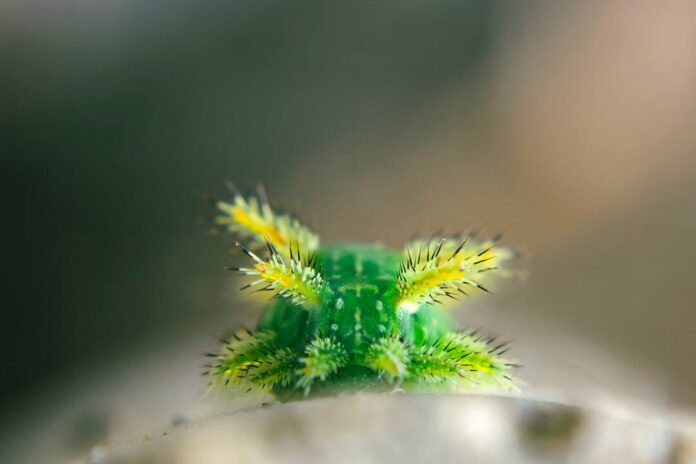Stinging caterpillars are the caterpillars that have hairy bodies that can cause stinging pain. These bugs do not attack people, they only sting upon contact when we pick them up or touch them. The hairs on caterpillars are coarse and sharp enough to pierce the skin to deliver the venom. You will find 11 stinging caterpillars on the list below, feel free to check them out.
1Black-Waved Flannel Moth Caterpillar
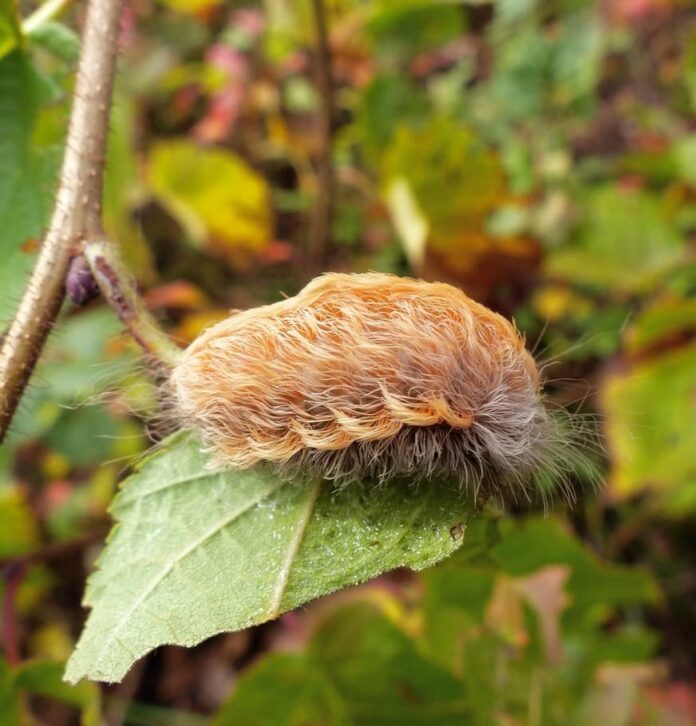
Black-waved flannel moth caterpillars are found along the east coast of the United States where they feed on various shrubs and trees. They are common in areas like backyards, parks, playgrounds, and trails. Their favorite leaf meals are from alder, ash, elm, hickory, maple, oak, sycamore, and willow. A black-waved flannel moth caterpillar is a small caterpillar that grows to a size of 2 to 4 centimeters. The frilly hairs on the caterpillars is fuzzy, and their colorations vary among bright white, brown, gray, rusty orange, and yellow. This caterpillar produces venom that it delivers through the hollow urticating hairs that can penetrate human skin.
If you touch one, the venom will put you through a burning sensation, headache, inflammatory dermatitis, pain, and swollen lymph nodes. The symptoms depend on where the victim is stung and how many spines get embedded into the skin. And the symptoms are more serious with those with allergies as the venom can also cause muscle spasms and seizures. For light stinging, you can treat it by using tape to pull off the hairs from your skin. Then put the ice on the area and use hydrocortisone cream, and visit your doctors for prescribed painkillers.
2Giant Silkworm
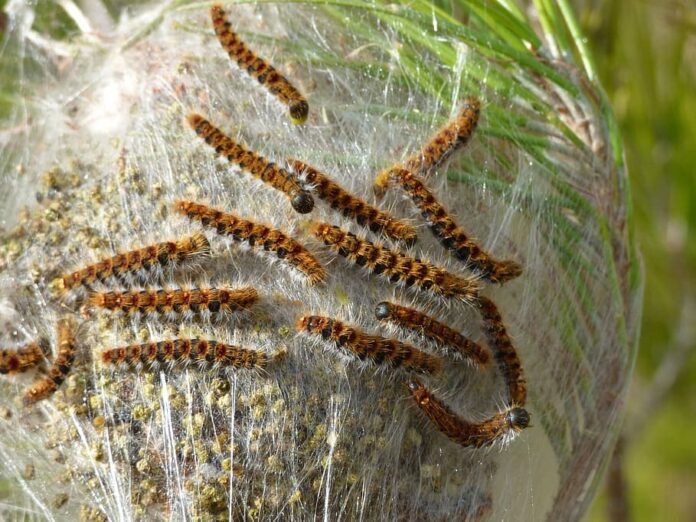
Here you are looking at one of the most venomous caterpillars in the world, the giant silkworm caterpillars. They are responsible for over 500 deaths, and proper treatment for their venom is not widely available. Giant silkworm caterpillars feed on a wide range range of shrubs and trees in the southern part of Brazil. Along with that, they are also found in Argentina, Paraguay, and Uruguay as well. The interesting thing about this caterpillar species is that they are large, growing to a size of 4.5 to 5.5 centimeters. Their background colors range from green to brown, and their entire bodies are covered in rows of detachable spines.
These urticating bristles of different sizes can inject a potentially deadly venom and they are poisonous if ingested. A simple touch is enough to deliver a painful sting, and they have been responsible for many human deaths. Its venom contains anti-clotting agents that cause internal bleeding and spread through the internal organ. The symptoms will spread through the body, causing massive blood leakage into the brain, leading to death in most cases. It is not that you approach and touch one, you could be handling up a pile of leafy branches. Or you could walk in shrubs, their spines can easily puncture the skin and release toxins. They are extra dangerous because they like grouping together low on tree trunks during the day. So the risk of accidentally brushing or falling into their groups is even higher.
3Hag Moth Caterpillar
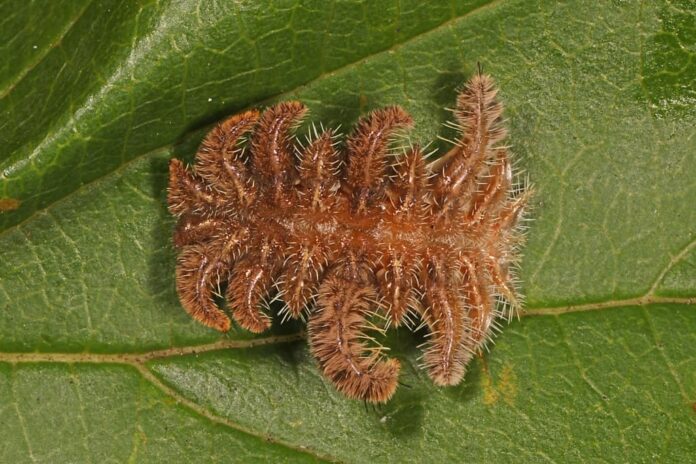
It is obvious that we would not touch something that looks like this but there are curious people out there. Being tiny, these caterpillars are only 1.5 to 2.5 centimeters long, and they live on the underside of leaves. This caterpillar has a light brown body but can also range from reddish to grayish brown. A hag moth caterpillar has a flat body with 9 pairs of curly tubercles of various lengths projecting from it. They look like legs but they are not, the caterpillars’ real legs are underneath their body.
Each tubercle is covered in hairs, and these hairs can cause irritations to humans. The worst part? You don’t have to directly touch these stinging caterpillars because sometimes these tubercles fall off during the defending mode. Accidentally touching one of these fallen legs can also sting you. Those hair bristles have toxin glands at their base, and the toxin is released upon contact. The symptoms can be burning or stinging, inflammation, itching, or redness similar to a bee sting.
4Io Moth Caterpillar
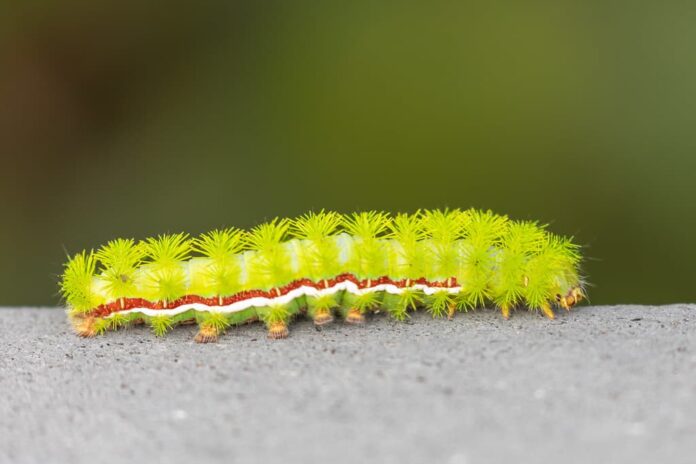
An Io moth caterpillar is pale green with a yellow-white and red stripe that runs on its body. It can be as big as 6.5 centimeters long, and the stinging organs on its back are clustered on fleshy protrusions. Io moth caterpillars feed on a large variety of host plants such as elm, hibiscus, maple, willow, and wisteria. The spines of these caterpillars are hollow, and they break off easily to embed deeply into the skin. Though not life-threatening, you will immediately feel a burning sensation followed by itchiness and redness with even the slightest touch. The pain will subside after a few hours, and swelling will decline after around 8 hours.
5New England Buck Moth Caterpillar
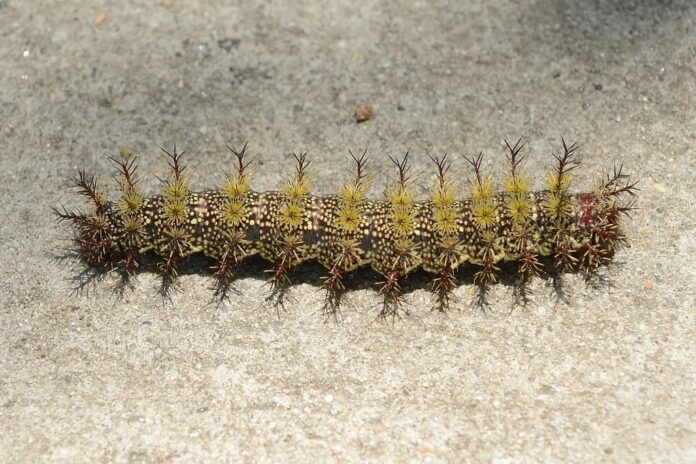
Endemic to New England, specifically Maine, Massachusetts, and New Hampshire, New England buck moth caterpillars are 6.5 centimeters big. A caterpillar of this moth species is black in color, and it has black and orange spines on its back. The spines are multi-branched, and there are multiple rows of these spines on its body. The ones on the top of the body are longer with more branches while the ones on the sides are shorter. These protruding spines can penetrate human skin, and the pain is not pleasant. The common symptoms are painful stings and swellings, at least the venom is not severe.
6Puss Caterpillar
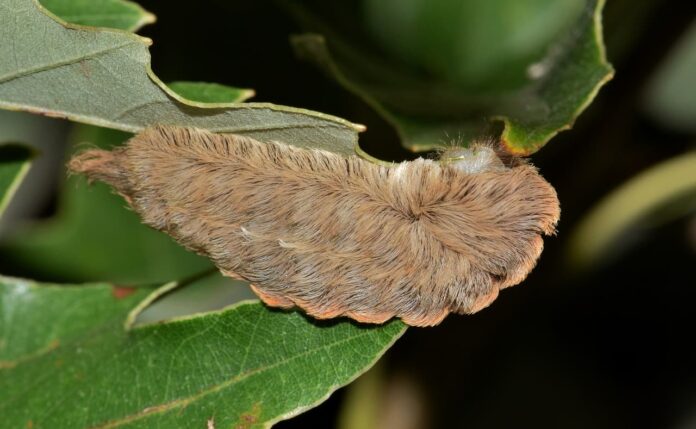
Looking absolutely unique for a caterpillar, a puss caterpillar is completely covered with brown or gray hairs. The color of the caterpillars can vary from downy grayish white to golden brown and dark charcoal gray. It is only around 2.5 centimeters long but it can sting you just like the bigger ones. Underneath those soft hairs are stiff spines that will break off in your skin and cause severe pain. The bigger the caterpillar, the more toxic its venom becomes. The symptoms from the sting are abdominal distress, blisters, fever, headache, nausea, rashes, and seizures. Some victims described the pain as similar to a blunt-force trauma or a broken bone.
The good thing is that at least there are ways to treat the sting, and the venom is not deadly. If you still see the spines on your skin, use a cellophane tape to remove them all out. Then you may use ice packs or other alternatives such as hydrocortisone cream or oral antihistamine on the wounds. One last thing that you should know is that the sting is powerful enough the pain can last for days or weeks.
7Saddleback Caterpillar
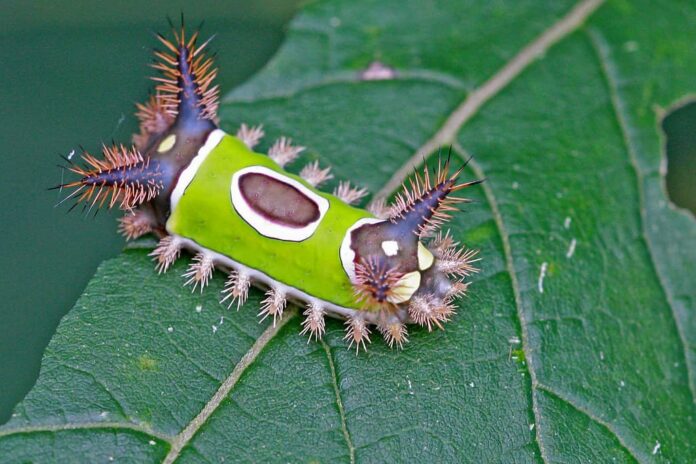
Probably one of the easiest-recognized stinging caterpillars, a saddleback caterpillar has a very fascinating appearance. A saddleback caterpillar is brown on the front and hind ends, its middle is green with a brown oval. It looks almost as if it is wearing a fancy green shirt. The saddleback caterpillars are one of the most dangerous stinging caterpillars, and they are so common in ornamental plants. They feed on a wide range of crops, shrubs, and trees in the gardens. So their most common victims are actually gardeners who accidentally brush against them.
This caterpillar can grow up to 2 centimeters long, and its stout body has stinging hairs on the front and end. There is also a row of smaller stinging organs on each side of its body as well. Not different from other stinging caterpillars, its spines also break off easily to embed deeply into the skin. Upon contact, a victim will experience intense burning, inflammation, swollen rash, and possible red blanching around the affected area. The toxin in the venom can cause tissue damage along with acute urticaria or rashes of red round welts that itch and swell.
8Spiny Oak Slug
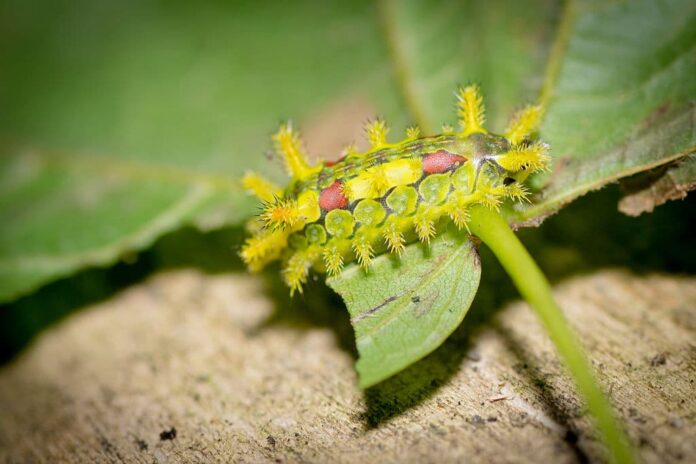
Many stinging caterpillars look quite similar to each other, and spin oak slug caterpillars are one of those. A spiny oak slug is 2 centimeters long, and it has an abundance of spines protruding from its flat body. Colorations on the body of this species are a mix of green, orange, yellow, and/or red. The difference is that the sting from this caterpillar is less dangerous than other stinging caterpillars out there.
Common symptoms are usually burning or stinging sensation, inflammation, itchiness, and redness in the affected areas. They feed on a wide variety of common deciduous shrubs and trees, and they usually rest on the lower surfaces of leaves. Those plants are apple, ash, basswood, beech, birch, blueberry, cherry, chestnut, hackberry, hickory, maple, oak, poplar, sycamore, and willow. It is not uncommon for them to accidentally fall from those trees, so make sure to be extra careful.
9Spun Glass Slug
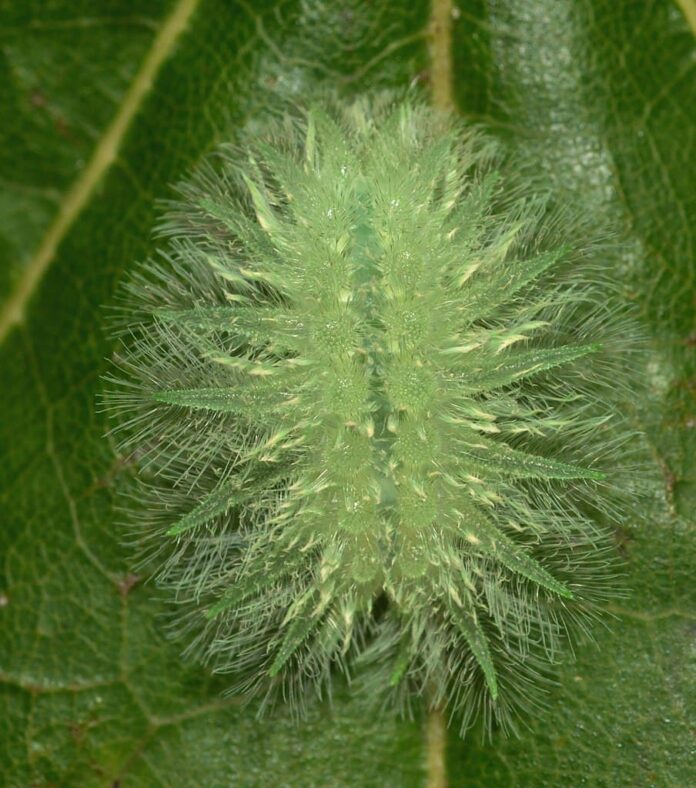
Beautiful but dangerous, spun glass slug is clearly one of an eye-catching kind. This stinging caterpillar is almost transparent, and this glassy body is covered in spiny hairs that contain venom. The venom from their fascinating crystal green barbs can cause excruciating stinging pain and subsequent raging dermatitis. However, their venom is not fatal to humans. Spun glass slug caterpillars are only found on beech and oak trees, and encounters with them are rare.
10Stinging Rose Caterpillar
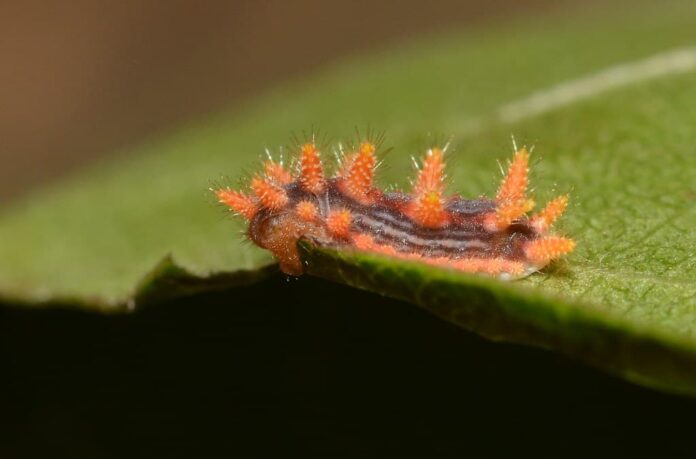
This is another member of the stinging caterpillars but stinging rose caterpillars are rather small with a size of 2 centimeters. The dangerous part? A small body can cause a sting that hurts more than you can imagine. It has 7 pairs of horns that are covered with spines along with smaller spiny bumps on each side. A slight brush against human skin is enough for the tips of the spines to break off and sting you. The site will swell and stay painful for hours or even up to days. Stinging rose caterpillars are not difficult to recognize, they have a colorful and stout body that is orange, yellow, and white. It looks so pretty but make sure to admire that beauty from a distance to avoid pain later.
11White Flannel Moth Caterpillar
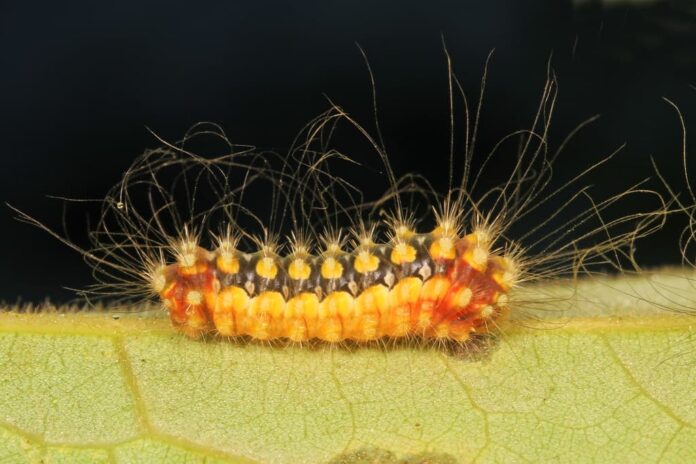
White flannel moth caterpillars are around 1.7 centimeters big, and they have long stinging hairs on their black or reddish-black body. Fuzzy and hairy are always a sign to notice that that caterpillar is stingingly dangerous. The reactions to the sting depend on the person’s sensitivity but most usually experience some similar symptoms. Those are burning, dermatitis, itching, lesions, rash, swelling, and even fever and nausea.
Related Post: Cute Caterpillars That You Should See

